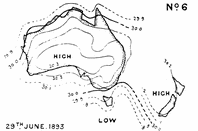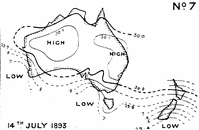


Meteorological Work in Australia
Meteorological Work in Australia: A Review
Map No. 1—February 18th, 1890
Map No.2—January 14th, 1891
Map No.3—March 12th, 1891
Map No. 4, February 5th. 1890, and Map No .5, May 27th, 1893
Map No. 6, June 22nd, 1893
Map No. 7, July 14th, 1893
Seasonal Forecasts
Droughts
Conclusion
Index
Search
Help
Contact us

Is a typical winter map, an anticyclonic area resting over the interior. with its maximum extending from the Great Australian Bight to the centre of the continent, and in a long loop from Western Australia to near the coast range in Queensland, whilst over the Southern Ocean we have the usual low pressure belt.

The weather was mostly fine and clear in Western Australia; in South Australia dry south-east winds were blowing in the interior from Lake Eyre to the north coast, and the weather was cloudy fine to gloomy, and in parts foggy, with misty rain over southern districts. On the Victorian coast it was cloudy and showery, and fine and clear inland there and in New South Wales; fine but more or less cloudy in Queensland and the Northern Territory. There were frosts in early morning in Victoria and southern Queensland.
Subsequent maps show that the "high" gradually increased in energy till the 1st of July: then decreased slightly during the next day or two, the centre of the anticyclone remaining stationary over the southern part of South Australia. Very cold frosty nights were experienced inland over South Australia and New South Wales, the thermometer on grass at the Sydney Observatory on the morning of the 4th reading 24°—the lowest reading there in thirty-five years.
Map No. 7, July 14th, 1893
Is another typical winter map showing an extended series of low pressure waves passing in rapid succession easterly along the south coast—one rounding the Leeuwin. another to the west of Tasmania, while a third is over southern New Zealand, with its centre to the south of the island. A moderate "high" covers Australia from west to east.

The trend of the low pressure isobars on the south coast is a very general feature. Reaching up northwards into Victoria. they curve abruptly southwards. rounding Tasmania to the south, and then recurring northwards up the east coast. In many maps this is much more marked. The same feature may be seen in maps 3 and 6. This abrupt northerly extension east of Tasmania frequently gives rise to strong southerly winds on the New South Wales coast.
The weather was cloudy to threatening and showery in West Australia; cloudy to gloomy and threatening, and in a few places showery, with squalls on coast, in South Australia, Victoria, and Tasmania; fine and clear in north-east New South Wales, unsettled in west; cloudy to gloomy in south and east parts of Queensland, clear in centre and north-west districts.
People in Bright Sparcs - Todd, Charles
 |
Bureau of Meteorology |  |
© Online Edition Australian Science and Technology Heritage Centre and Bureau of Meteorology 2001
Published by Australian Science and Technology Heritage Centre, using the Web Academic Resource Publisher
http://www.austehc.unimelb.edu.au/fam/1564.html